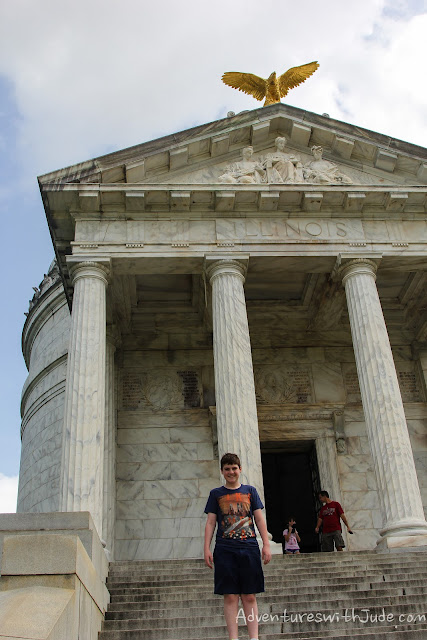We began our tour at the visitor's center, where there was a campaign summary presentation (as well as a separate film), and then headed out for a cd-based car tour.
Of course, there were all the positional and regimental monuments, but Matthew was most excited about this Illinois monument.
It's modeled after the Pantheon. He learned about this building last year, so was excited to share what he knew. While the opening at the roof would serve as a chimney, it also had a second purpose -- as the sun fell on the walls, it worked as a clock.
This second photo was taken about three minutes later.
And this one after he shared what he had learned - about another four or five minutes had gone by.
On Sunday we had learned about the role of the 101st Airborne during Operation Overlord, the Normandy invasion in WWII. Today we learned the origin of the eagle on their insignia -- Old Abe was the mascot of a Civil War regiment from Wisconsin.
We also saw the remains of the USS Cairo, an ironclad ship that had sunk.
Luke stumped me! He recognized this man - James Eads - right away. It took me a bit to place him. He also designed a St. Louis bridge over the Mississippi that used Carnegie steel.
We also had the chance to drive through the cemetery. Though much smaller than Gettysburg or Arlington, it has the same serene yet almost haunting feel, especially knowing that many of them men there are unknowns. At the time of the Civil War, there were manifests to determine who was in a battalion. If you didn't answer at roll call, they knew you were dead. But once you were dead, it was difficult to identify individual men because very few had identification on their uniforms. This poor system led to reforms, and is one reason why all soldiers are issued identification "dogtags" today.
As we drove through, our audiotour read the poem The Bivouac of the Dead, which is also written on plaques around the cemetery.
One of the final memorials on the park tour is the Missouri monument. Missouri was a divided state, and volunteers from here fought on both sides here. This memorial sums up the entire war into a single visual.
From the Civil War to the Civil Rights Movement -- after we finished at the park, it was time to hit the road.
Today's plan calls for exploring sites in Montgomery!
©2012- 2015 Adventures with Jude. All rights reserved. All text, photographs, artwork, and other content may not be reproduced or transmitted in any form without the written consent of the author. http://adventureswithjude.com





















No comments:
Post a Comment